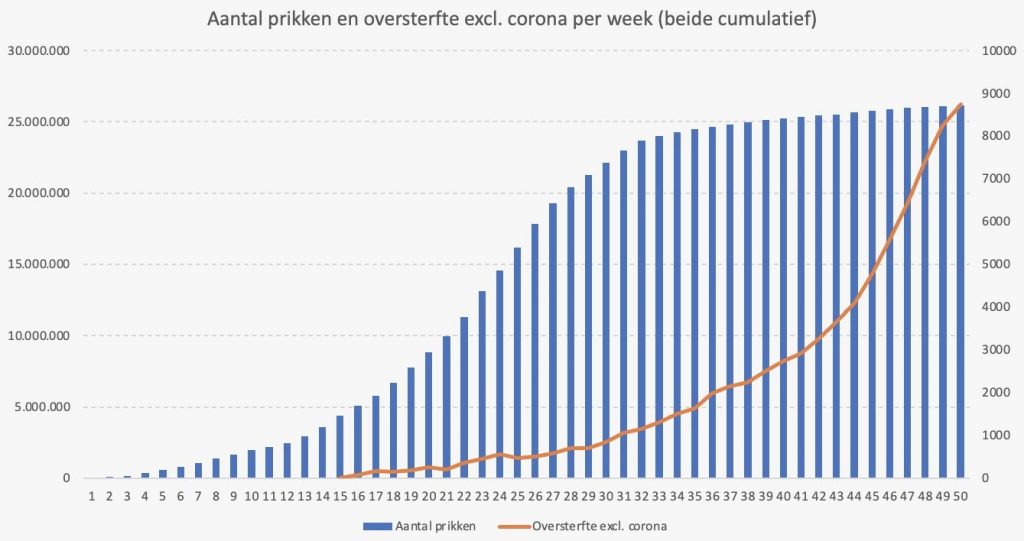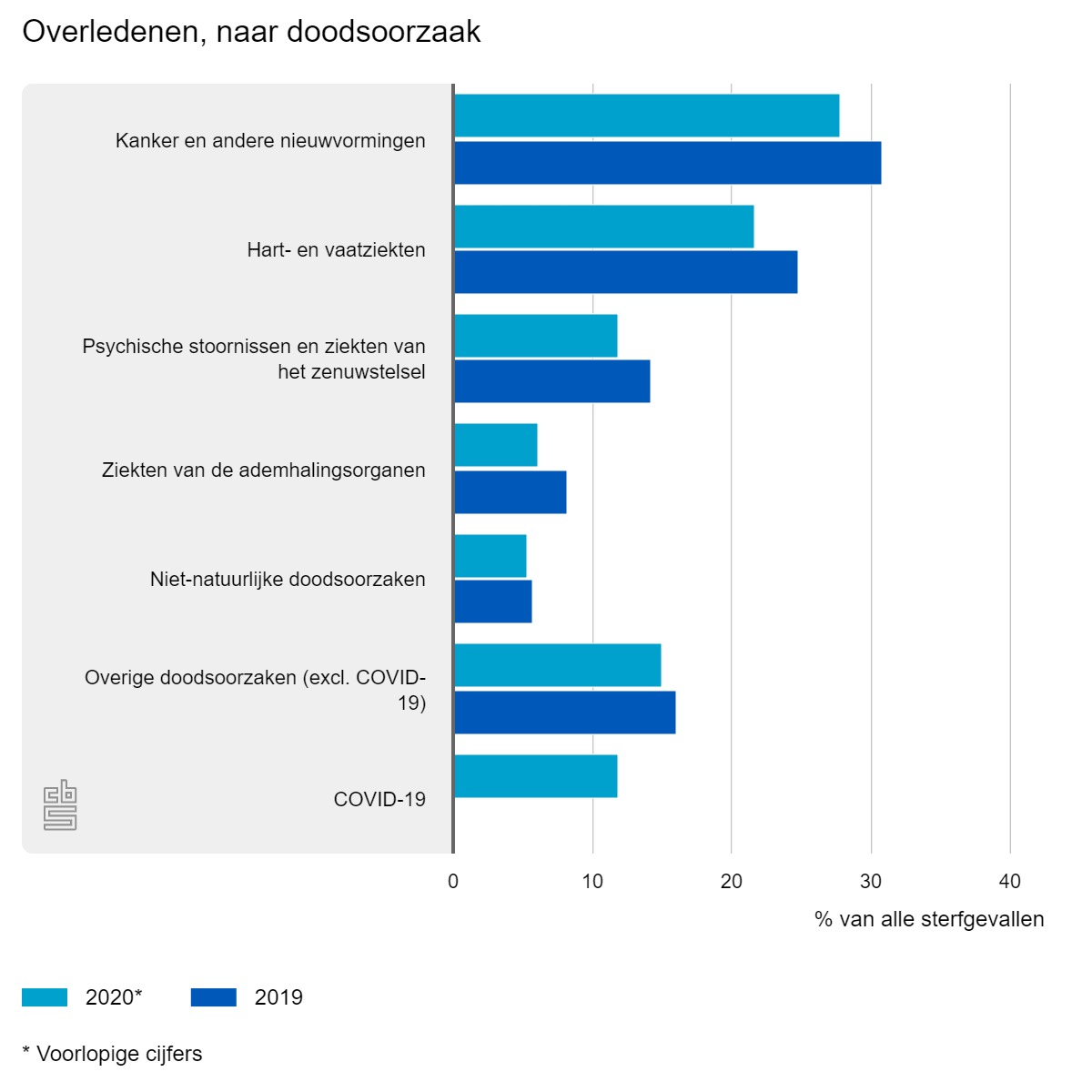CBS has formally issued a preliminary report on the causes of death up to and including August 2021. We have been looking forward to this report for a long time because the causes of death may contain clues about the role of vaccinations in the excess mortality peak at the end of 2021. If, for example, the causes of death preventable by medical intervention have risen significantly, it is conceivable that postponed care has led to higher mortality. If the increase in mortality is mainly reflected in respiratory disorders, you could think that they must have been Covid cases after all.
Because it is precisely this information that cannot be found in the report, we speak of a 'formal' report. It is not a report in the sense of providing insight into activities or developments. The rapporteurs (or editors-in-chief) do not seem to want to reveal the figures in question yet. The government is undermining confidence in this way. Now the figures that have been reported can also be interpreted to some extent. The accounts will have to be balanced. That means again: working indirectly and indicatively, without speculating too much.
We have already discussed other aspects such as the timing of the excess mortality peak, which does not rhyme with long-term causes. For now, it is only about the distribution of causes of death in the latest CBS document, which runs until August 2021.
What could indicate vaccination mortality?
If known vaccine side effects can be found in increased causes of death, this is an obvious signal that this possible causality must be investigated. In the past, a few dozen deaths worldwide were sufficient reason to pause ongoing vaccination campaigns. At least that is not the case now. In the Netherlands alone, there are thousands of possible vaccine deaths about which the population is kept in the dark. From America we only hear the winged mantra 'the benefits outweigh the risks' and that is gladly imitated in the Netherlands.
The pharmaceutical complaints desk Lareb catches troublemakers and does little else when it comes to the side effects of a hastily tested drug. After all, nothing like this has ever happened before. In acknowledging new side effects, Lareb has always been lagging behind the facts – and with great reluctance, whether it was thrombosis, myocarditis, menstrual complaints or cerebral infarctions: they were initially invariably denied by the institute that was set up to be the first to identify them. Presumably with the best intentions in the context of vaccination readiness.
As long as the observed vaccine damage is not greater than the imagined virus damage, vaccination will be given. The calculation on which this is based is unclear. Is it about counting body bags? Do people look at QALYs? Collateral damage? How far should the balance between pros and cons tip? (See also Previous thoughts on this issue)
In any case, the assessment is based on models, focusing mainly on the darkest scenarios. After all, people only think in terms of risk avoidance. Without exception, the models have greatly exaggerated the virus damage, sometimes by a factor of 100 and even higher. The same thing happens with estimates: the lethality of the infection has dropped from roughly 3% to 0.15% in less than a year (before Omicron), which is a factor of 20. These models, modelers and experts are still held in high esteem and followed by the government.
The models reflect nothing more than the agony of frightened (especially) men who owe their positions to good faith in the healthcare industry and its suppliers. The world has been held hostage with their fear models.
Enough opinion.
Back to the numbers
Last year: pre-vaccination
Let's first look at last year, when the government declared Covid-19 the No. 1 cause of death. That was wrongly, as shown in this article. In any case, this was the ranking presented on volksgezondheid.info
(click=enlarge)
CBS quite rightly seemed not interested in that propaganda and reported as usual. The combination of 'mental disorders' and 'diseases of the nervous system' is questionable. The latter category includes, for example, Guillain-Barré syndrome and other autoimmune diseases. These are not really mental illnesses.
I mention this because it may play a role later: autoimmune diseases and Guillain-Barré in particular have previously been mentioned in connection with vaccine side effects. Mental disorders would be more likely to be expected with lockdown stress, or with disproportionate fear of the virus. We see every day that this can lead to psychosis.
Vaccination year 2021 to August
In pre-vaccination year 2020, the main causes of death were reduced compared to 2019, at the expense of the new kid on the block: Covid-19. The new disease caused 'new' deaths, but a substantial part of the Covid mortality was taken from other causes of death (see earlier article). 2021 should give a different picture with fewer deviating values.
2021, the second Covid year with characteristics:
- The vaccination campaign is over
- The booster campaign is almost complete
- There is also built-up natural immunity
- Treatment methods have improved
- Timely lockdowns, curfews, school closures, testing for access, QR codes etc. etc.
In addition, important knowledge was applied in 2021 that was gained through a lot of trial and error in the school of hard knocks of 2020. This wealth of experience has resulted in refined guidelines such as washing hands, keeping one and a half meters and above all a lot of testing. And a sign 'fresh air' at the press conferences. That aside.
Under these favorable conditions, the causes of death should normalize towards the old situation of 2019, with at most a small role for Covid-19. This does not appear to be the case. CBS indicates that the 'non-Covid' causes of death in 2021 have fallen even further than they already were in 2020: with 1179 fewer deaths.
CBS suggests that the cause of the decline is mainly to be found in the increased category "Other". This category is not specified; It is anything that does not fall under the reported categories of cancer, cardiovascular disease, nervous system and mental disorders or respiratory organs, accidental falls, suicide and traffic accidents.
"Other" therefore includes blood diseases and disorders of the immune system.
What could offer hope is that heart failure is not behaving as expected. Now, the vaccine-induced peri-/myocarditis on total 'heart failure' does not make a significant difference. After all, it is a huge category with 36,500 deaths annually, where even a natural fluctuation can easily run into the hundreds and perhaps thousands. There are now even fewer than last year. However, we assume that these specific conditions (peri- and myocarditis) are still categorized under "Cardiovascular diseases" and have not been set apart, just as Covid has also been removed from the category "Diseases of respiratory organs".
The causes of death of the unexplained excess mortality therefore seem to be mainly in the category "Other". We see it increasing throughout the year, rising in line with the orange line of unexplained mortality.


It remains to be seen whether the category "Other" will continue to rise in accordance with the orange line in the bar graph. How long will it take before we gain insight into the causes of unexplained (excess) mortality?
For more graphs and the numerical substantiation with a moral compass, go to the website of the Eucalyptic Society



